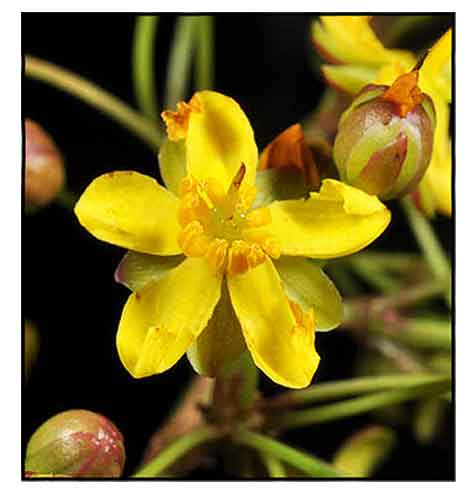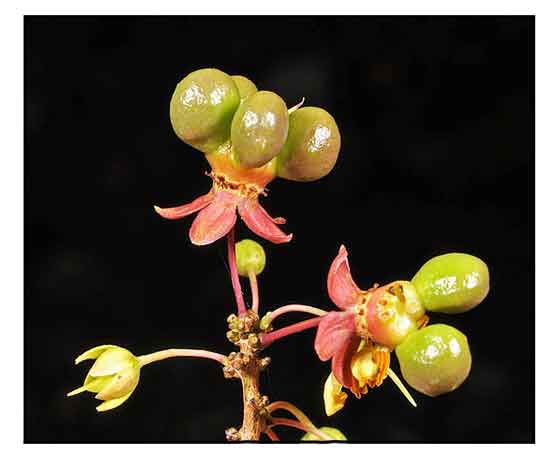
Family • Ochnaceae
Sasahit
Campylospermum serratum (Gaertn.) Bittrich & M.C.E.Amaral
TOOTHED-LEAF GOMPHIA
Chi ye sai jin lian mu
| Scientific names | Common names |
| Campylocercum hohenackeri Tiegh. | Minsaray (Mindoro) |
| Campylocercum metzii Tiegh. | Sasahit (Tagalog) |
| Campylocercum neriifolium (Bartell.) Tiegh. | Simahima (Bikol) |
| Campylocercum pauciflolim Tiegh. | Toothed-leaf gomphia (Engl.) |
| Campylocercum striatum Tiegh. | |
| Campylocercum zollingeri Tiegh. | |
| Campylospermum abbreviatum Tiegh. | |
| Campylospermum angustifolium (Vahl) Tiegh. | |
| Campylospermum beccarianum (Bartell.) Tiegh. | |
| Campylospermum borneense (Bartell.) Tiegh. | |
| Campylospermum cumingii Tiegh. | |
| Campylospermum kingii Tiegh. | |
| Campylospermum leschenaultii Tiegh. | |
| Campylospermum malabaricum (DC.) Tiegh. | |
| Campylospermum nodosum Tiegh. | |
| Campylospermum perakense Tiegh. | |
| Campylospermum plicatum Tiegh. | |
| Campylospermum retinerve Tiegh. | |
| Campylospermum rheedei Tiegh. | |
| Campylospermum serratum (Gaertn.) Bittrich & M.C.E.Amaral | |
| Campylospermum striatum (Tiegh.) M.C.E.Amaral | |
| Campylospermum strictum Tiegh. | |
| Campylospermum sumatranum (Jack) Tiegh. | |
| Campylospermum thwaitseii Tiegh. | |
| Campylospermum vahlianum Tiegh. | |
| Campylospermum walkeri Tiegh. | |
| Campylospermum wallichianum Tiegh. | |
| Campylospermum zeylanicum (Lam.) Tiegh. | |
| Cercinia annamensis Tiegh. | |
| Cercinia brevis Tiegh. | |
| Cercinia doumeri Tiegh. | |
| Cercinia elongata Tiegh. | |
| Cercinia thorelii Tiegh. | |
| Cercinia wightii Tiegh. | |
| Diporidium rufescens (Thwaites) Tiegh. | |
| Discladium dalzellii Tiegh. | |
| Discladium gaudicahudii Tiegh. | |
| Discladium koeigii Tiegh. | |
| Discladium leschenaultii Tiegh. | |
| Discladium lucidum (Lam.) Tiegh. | |
| Discladium microphyllum Tiegh. | |
| Discladium planchoni Tiegh. | |
| Euthemis pulcherrima Wall. | |
| Gomphia angustifolia Vahl | |
| Gomphia ceylanica Spreng. | |
| Gomphia malabarica DC. | |
| Gomphia microphylla Ridl. | |
| Gomphia oblongifolia Ridl. | |
| Gomphia serrata (Gaertn.) Kanis | |
| Gomphia striata (Tiegh.) C.F.Wei | |
| Gomphia sumatrana Jack | |
| Gomphia zeylanica (Lam.) DC. | |
| Maesia serrata Gaertn. | |
| Meesia serrata Gaertn. | |
| Ochna angustifolia (Vahl) Kuntze | |
| Ochna crocea Griff. | |
| Ochna lucida Lam. | |
| Ochna rufescens Thwaites | |
| Ochna sumatrana (Jack) Kuntze | |
| Ochna zeylanica Lam. | |
| Ouratea angustifolia (Vahl) Baill. | |
| Ouratea arcta Craib | |
| Ouratea beccariana Bartell. | |
| Ouratea borneensis Bartell. | |
| Ouratea crocea (Griff.) Burkill | |
| Ouratea hueensis Pierre ex Lecomte | |
| Ouratea lobopetala Gagnep. | |
| Ouratea megacarpa Ridgl. | |
| Ouratea microphylla (Ridl.) Craib | |
| Ouratea neriifolia Bartell. | |
| Ouratea serrata (Gaertn.) N.Robson | |
| Ouratea striata (Tiegh.) Lecomte | |
| Ouratea sumatrana (Jack) Gilg | |
| Ouratea thorelii (Tiegh.) Lecomte | |
| Ouratea zeylanica (Lam.) Alston | |
| Pleopetalum lucidum (Lam.) Tiegh. | |
| Walkera serrata (Gaertn.) Forsyth f. | |
| Walkera zeymonensis DC. | |
| Gomphia serrata is a synonym of Campylospermum serratum. | |
| Campylospermum serratum is an accepted species. It has 78 synonyms. KEW: Plants of the World Online | |
| Other vernacular names |
| BORNEO: Chenaga lampong. |
| CHINA: Chi ye sai jjin lian mu. |
| CAMBODIA: Kongkea chhmool, Angkie sel, Chiem antong. |
| INDONESIA: Kayu ndolak, Kayu sepat, Tengkejing kering. |
| KANNADA: Addane, Kempu kallu, Kempu kunthala. |
| KHMER: Angkie chhmool, Angkier tchmol, Bampu:eng rueng, Chhiem angtueng. |
| LAOS: Huan kouang, Hang kuang, Kouang non. |
| MALAYALAM: Poea-tsjetti, Tsjocatti, Valermani. |
| MALAYSIA: Kelutan, Magang-magang, Mata ketam batu. |
| MARATHI: Valermani. |
| SINHALA: Go kera, Bo kera, Kera. |
| TAMIL: Katharai, Ramanchi. |
| THAILAND: Hang kwang phu, Kapito, Thong pling. |
| VIETNAM: Cay dua bap, Duc dac, Mai canh lom. |
April 2023
![]()
 |
| PHOTOS / ILLUSTRATIONS |
| IMAGE SOURCE: Photograph: Campykisoermum serratum / FarEnd2018 / CC by SA 4.0 / click on image to go to source page / Wikipedia |
| OTHER IMAGE SOURCE: Photo : Ochnaceae - Campylospermum serratum / Fruits / Copyright © 2012 by P B Pelser & J F Barcelona (contact: pieter.pelser@canterbury.ac.nz)) [ref. DOL50302] / Non-Commercial Use / click on image to go to source page / Phytoimages.siu.edu |
| OTHER IMAGE SOURCE: Photo : Ochnaceae - Campylospermum serratum / Flower / Copyright © 2012 by P B Pelser & J F Barcelona (contact: pieter.pelser@canterbury.ac.nz)) [ref. DOL44216] / Non-Commercial Use / click on image to go to source page / Phytoimages.siu.edu |
Additional
Sources and Suggested Readings |
• |
DOI: It is not uncommon for links on studies/sources to change. Copying and pasting the information on the search window or using the DOI (if available) will often redirect to the new link page. (Citing and Using a (DOI) Digital Object Identifier) |
| List of Understudied Philippine Medicinal Plants |
• |
 |




